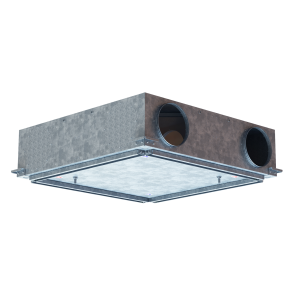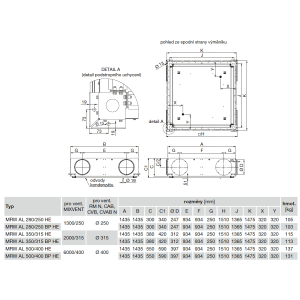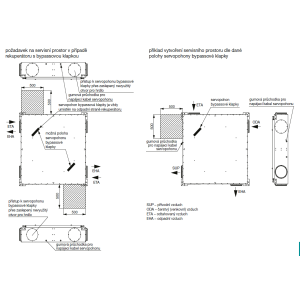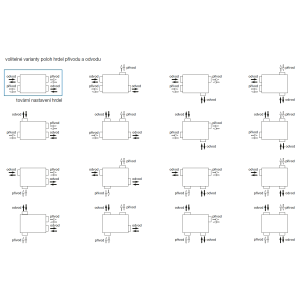Cabinet
It is made of galvanized sheet metal with round necks on the front sides of the recuperator. There are removable circular covers on the sides of the recuperator which can be interchanged with the circular throats as required. Condensate drains are installed at the bottom of the recuperator on the waste branch (the condensate drain on the air side before the recuperation can be blinded).
Recuperation
The aluminium plate heat exchanger meets the requirements of EC Regulation 1253/2014 and is built into the recuperator cabinet. Sizes 280, 350 and 500 can be supplied with a bypass damper which is on the fresh air supply side. The bypass damper servo drive is not included in the delivery.
Mounting
Only in a horizontal position (under the ceiling) with a 1° inclination to the waste drain pipe. The condensate drain must be connected via a siphon to the sewer pipe. For the recuperator variant with bypass damper, a service space must be provided for access to the bypass damper actuator. The servo drive power cable must be routed through a rubber grommet to the outer jacket. Other than the horizontal position, the technical department of Elektrodesign ventilators s.r.o. must be consulted.
Options
- MRW-AL H / Ø D HE - heat recovery exchanger without bypass damper, H - type designation, Ø D - throat dimension
- MRW-AL H / Ø D BP HE - heat recovery exchanger with bypass damper, H - type designation, Ø D - throat dimension
In the case of the variant with bypass damper, the bypass is located on the supply air side. The bypass damper actuator is located on the outlet side of the recuperator. The location of the bypass damper actuator can be changed as required. Access to the actuator is through a blinded unused throat opening. If the recuperator is covered by a soffit, a service hole must be created in the soffit for possible servicing of the bypass damper actuator. The minimum size of the service hole is shown in the figure below.
Instructions
The exchanger is resistant to corrosion and damp environments. It cannot be used in explosive environments, environments with chemical fumes, solvents and aggressive substances. To reduce the risk of contaminants clogging the exchanger, air filters must be installed on the fresh (outdoor) air and exhaust (indoor) air sides.
Information
Aluminum heat exchangers are suitable for modular systems with MIXVENT-TD, RM N, RK, CVB, CVAB N, CAB fans. The exchangers are universally applicable for central and decentral ventilation systems. The design is particularly suitable for building systems in circular ducts.
- low purchase costs
- high corrosion resistance for humid environments without aggressive substances
- easy maintenance
- cannot be used for explosive environments and solvent vapours
- temperature resistance -25 to +80 °C
Adherence to these instructions should not pose any safety, health or environmental risks in accordance with EC directives (CE marked). The same applies to other products used in the device or during installation. Consider the following warnings:
• Observe the safety instructions to prevent damage to the device or personal injury.
• The technical information in this manual must not be changed.
• It is forbidden to interfere with the motor of the device.
• In order for the device to comply with EC directives, the device must be connected to the mains in accordance with the applicable regulations.
• The device must be installed in such a way that under normal operating conditions it cannot come into contact with any moving part and / or live part.
• The device complies with the applicable regulations for the operation of electrical equipment.
• Always disconnect the device from the power supply before carrying out any work on it.
• Appropriate tools must be used when handling or maintaining the device.
• The device must only be used for the purposes for which it is intended.
• This appliance is not intended for use by children under 8 years of age and persons with reduced physical, sensory or mental capabilities, or lack of experience and knowledge, unless they have been given supervision or instruction concerning use of the appliance by a responsible person. The user must ensure that children do not play with the device. Cleaning and maintenance of the appliance must not be carried out by children without supervision.







 Share on Facebook
Share on Facebook Tweet
Tweet Send email
Send email